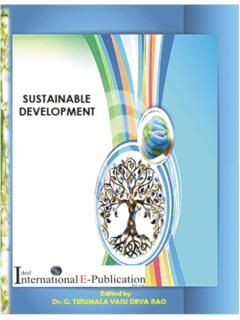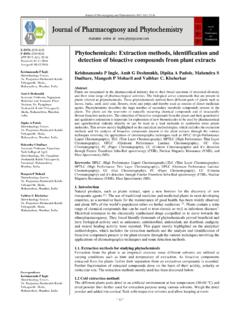Transcription of Guidelines for ATC classification
1 Guidelines for ATC classification and DDD assignment 2022 ISSN 1726-4898 ISBN 978-82-8406-258-7 Suggested citation: WHO Collaborating Centre for Drug Statistics Methodology, Guidelines for ATC classification and DDD assignment 2022. Oslo, Norway, 2021 Copyright WHO Collaborating Centre for Drug Statistics Methodology, Oslo, Norway. Use of all or parts of the material requires reference to the WHO Collaborating Centre for Drug Statistics Methodology. Copying and distribution for commercial purposes is not allowed. Changing or manipulating the material is not allowed. Guidelines for ATC classification and DDD assignment 25th edition WHO Collaborating Centre for Drug Statistics Methodology Norwegian Institute of Public Health 222 Sk yen N-0213 Oslo Norway Telephone: (47) 21078160 E-mail: Website: Previous editions: 1990: Guidelines for ATC classification1) 1991: Guidelines for DDD1) 1993: Guidelines for ATC classification 1993: Guidelines for DDD 1996: Guidelines for ATC classification and DDD assignment 1998: Guidelines for ATC classification and DDD assignment 2000: Guidelines for ATC classification and DDD assignment 2001: Guidelines for ATC classification and DDD assignment 2002: Guidelines for ATC classification and DDD assignment 2003: Guidelines for ATC classification and DDD assignment 2004: Guidelines for ATC classification and DDD assignment 2005.
2 Guidelines for ATC classification and DDD assignment 2006: Guidelines for ATC classification and DDD assignment 2007: Guidelines for ATC classification and DDD assignment 2008: Guidelines for ATC classification and DDD assignment 2009: Guidelines for ATC classification and DDD assignment 2010: Guidelines for ATC classification and DDD assignment 2011: Guidelines for ATC classification and DDD assignment 2012: Guidelines for ATC classification and DDD assignment 2013: Guidelines for ATC classification and DDD assignment 2014: Guidelines for ATC classification and DDD assignment 2015: Guidelines for ATC classification and DDD assignment 2016: Guidelines for ATC classification and DDD assignment 2017: Guidelines for ATC classification and DDD assignment 2018: Guidelines for ATC classification and DDD assignment 2019: Guidelines for ATC classification and DDD assignment 2020: Guidelines for ATC classification and DDD assignment 2021: Guidelines for ATC classification and DDD assignment 1) A co-publication between the WHO Collaborating Centre for Drug Statistics Methodology and the Nordic Council on Medicines PREFACE The Anatomical Therapeutic Chemical (ATC) classification system and the Defined Daily Dose (DDD) as a measuring unit are recommended by the WHO for drug utilization monitoring and research.
3 The system is widely used internationally and the number of users is increasing. The purpose of preparing Guidelines is to make information about the ATC/DDD system available to the users. The members of the WHO International Working Group for Drug Statistics Methodology have given expert advice and comments on the work with these Guidelines . This edition of the Guidelines for ATC classification and DDD assignment is based on the ATC classification index with DDDs valid from January 2022. The Guidelines consist of a general part including information about the procedures and data requirements for ATC/DDD assignment and alterations. The second part of the publication, the interpretative Guidelines , describes the different ATC levels down to the 4th level. These Guidelines should be consulted whenever the ATC/DDD system is used for drug utilization monitoring and research.
4 They describe particular issues, which have been discussed and resolved by consensus of the Working Group. The Guidelines and the ATC index with DDDs are updated annually. Both publications can be ordered as electronic or paper copies (English or Spanish versions) from the Centre (order form, see website ). A pdf document of the Guidelines and a searchable version of the ATC/DDD index linked to the text from the Guidelines are available on the website (ATC/DDD index). We hope this book will prove helpful to the users of the ATC/DDD system. Suggested improvements can be addressed to the WHO Centre in Oslo. Oslo, December 2021 WHO Collaborating Centre for Drug Statistics Methodology Norwegian Institute of Public Health Staff of the Centre Christian Lie Berg, MScPharm/MPH Hege Salvesen Blix, MScPharm/PhD Live Storehagen Dansie, MScPharm/MPhil Int Comm Health Miljana Ilic, MScPharm Ignatios Ioakeim Skoufa, MD Irene Litleskare, MScPharm Mohammad Nouri Sharikabad, MScPharm, PhD Kristine Olsen, MScPharm Hilchen Thode Sommerschild, MD, PhD Tove Granum, secretary 7 TABLE OF CONTENTS I.
5 Introduction .. 10 A. History of the ATC/DDD system .. 10 B. Present Organizational responsibility for the ATC/DDD system .. 10 1. WHO Collaborating Centre for Drug Statistics Methodology .. 10 2. WHO International Working Group for Drug Statistics Methodology .. 11 C. The purpose of the ATC/DDD system .. 14 II. The anatomical therapeutic chemical (ATC) classification system .. 14 A. Structure and nomenclature .. 14 B. Inclusion and exclusion criteria .. 15 C. Principles for classification .. 16 1. Therapeutic use or pharmacological class .. 16 2. Only one ATC code for each route of administration .. 17 3. More than one ATC code for a medicinal substance .. 17 4. New ATC groups and other groups (X groups) .. 18 5. Other general principles .. 18 D. classification of combination products .. 19 E. Principles for changing ATC codes .. 21 F. The EphMRA classification system.
6 22 III. DDD (Defined Daily Dose) .. 23 A. Definition and general considerations .. 23 B. Principles for DDD assignment .. 23 1. General principles .. 23 2. Combination products .. 25 3. Other factors .. 27 a) Fixed doses .. 27 b) Depot formulations .. 27 c) Intermittent dosing .. 27 d) Duration of treatment .. 27 4. Selection of units .. 28 8 C. Pediatric DDD .. 29 D. Principles for reviewing and changing DDD .. 29 E. Description of other drug utilization metrics .. 31 IV. Uses of the ATC/DDD methodology .. 32 A Implementation and maintenance of the ATC/DDD methodology 32 B. Drug utilization .. 33 1. Data sources .. 34 2. DDD indicators and interpretations .. 35 C. Drug Safety Assessment .. 37 D. Drug 38 E. Drug costs, pricing, reimbursement and cost-containment .. 38 F. Pharmaceutical marketing purposes .. 39 V. Procedures and data requirements for ATC/DDD assignment and alterations.
7 40 A. Requests for ATC classification .. 40 1. Procedures and timing .. 40 2. Data requirements for submission .. 42 B. Requests for ATC changes .. 43 1. Procedures and timing .. 43 2. Data requirements for submission .. 44 C. Requests for DDD assignment .. 44 1. Procedures and timing .. 44 2. Data requirements for submission .. 46 D. Requests for DDD changes .. 46 1. Procedures and timing .. 46 2. Data requirements for submission .. 46 VI. Description of ATC index with DDDs .. 47 VII. Other ATC classification systems .. 48 A. ATCvet 48 B. ATC herbal classification .. 48 VIII. ATC/DDD Interpretative Guidelines .. 49 9 ATC system main groups .. 50 A Alimentary tract and 51 B Blood and blood forming organs .. 81 C Cardiovascular system .. 91 D Dermatologicals .. 113 G Genito urinary system and sex hormones .. 129 H Systemic hormonal preparations, excl.
8 Sex hormones and insulins .. 142 J Antiinfectives for systemic use .. 149 L Antineoplastic and immunomodulating agents .. 166 M Musculo-skeletal system .. 176 N Nervous system .. 185 P Antiparasitic products, insecticides and repellents .. 204 R Respiratory system .. 211 S Sensory organs .. 223 V Various .. 232 List of terms .. 246 10 I. INTRODUCTION A. History of the ATC/DDD system The field of Drug Utilization Research (DUR) began attracting attention in the 1960 s. This followed the publication of a breakthrough study on drug consumption from 1966-1967 (pioneered by the WHO Regional Office for Europe) which further exemplified the importance and applicability of DUR (ref: Engel A, Siderius P. The consumption of drugs. Report on a study, 1966-1967. WHO Regional Office for Europe, Copenhagen 1968 (EURO 3101). In addition, the WHO symposium in 1969 highlighted the need for an internationally accepted classification system for drug utilization studies.)
9 As a result the Drug Utilization Research Group (DURG) was established and entrusted with the development of internationally applicable methods for DUR. Inspired by this interest, the Anatomical Therapeutic Chemical (ATC) classification was developed in Norway as a modification and extension of the European Pharmaceutical Market Research Association (EphMRA) classification system. In order to measure drug use, it is important to have both a classification system and a unit of measurement. To deal with the objections against traditional units of measurement, a technical unit of measurement called the Defined Daily Dose (DDD) was developed for use in drug utilization studies. Several decades of experience using ATC/DDD methodology has demonstrated its suitability in drug utilization monitoring and research. The increase in number of users indicates the usefulness of the system.
10 B. Present Organizational responsibility for the ATC/DDD system 1. WHO Collaborating Centre for Drug Statistics Methodology In 1981, the ATC/DDD system was recommended by WHO as the international standard for drug utilization studies, and in 1982 the WHO Collaborating Centre for Drug Statistics Methodology was established and given the responsibility for coordinating the development and use of the ATC/DDD system. In 1996, the Centre was recognized as a global centre. This was seen as important to allow close integration of international drug utilization studies and WHO s initiatives to achieve universal access to needed drugs and rational use of drugs particularly in developing countries. Access to standardised and validated information on drug use is essential to allow audit of patterns of drug utilization, identification of 11 problems, educational or other interventions and monitoring of the outcomes of the interventions.


